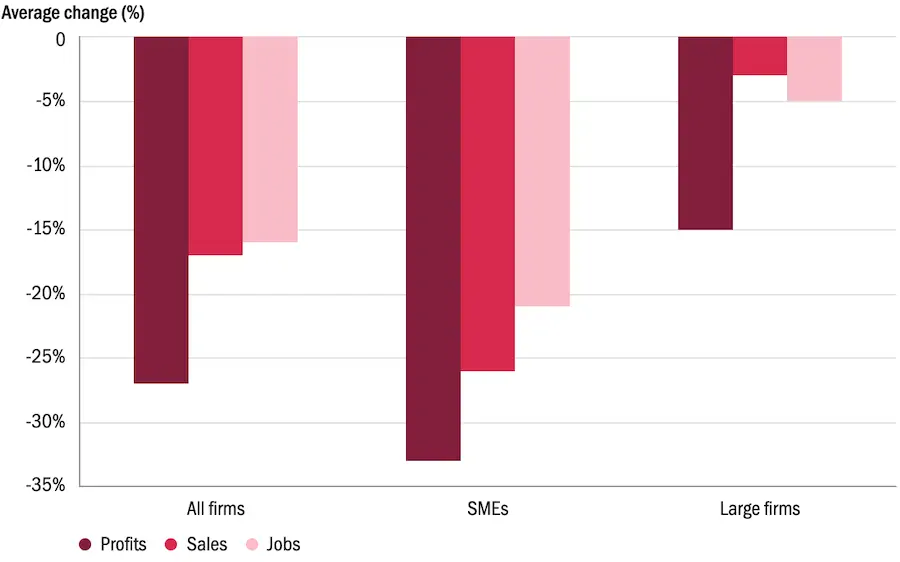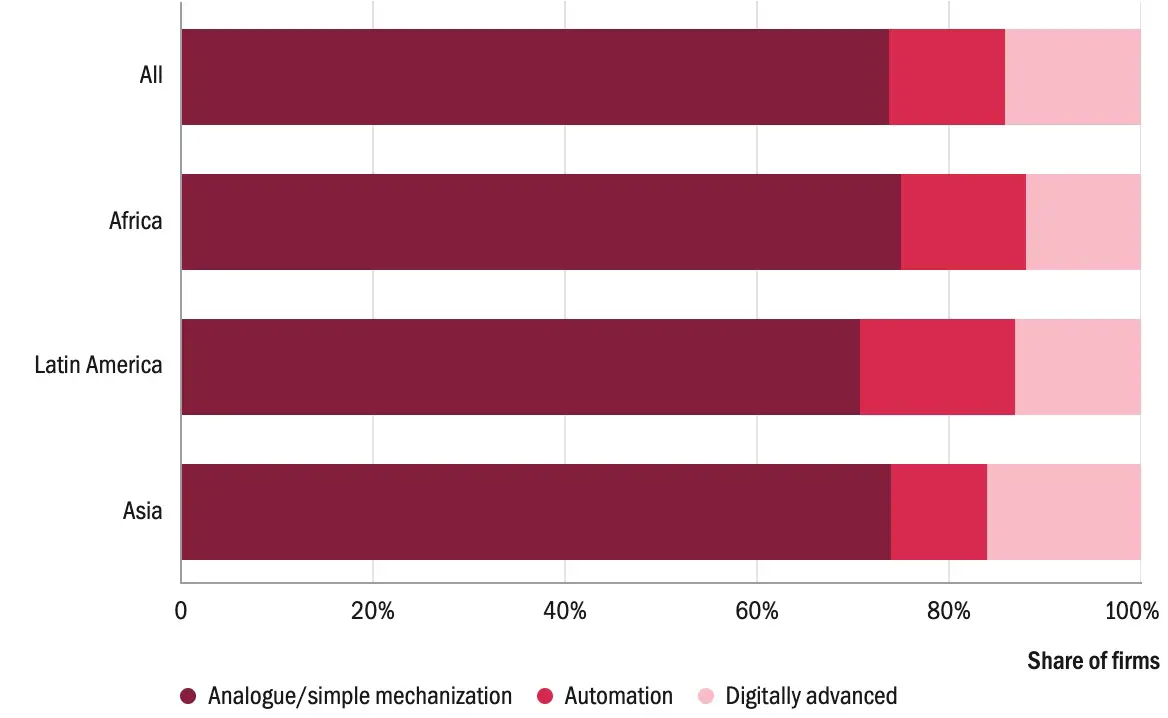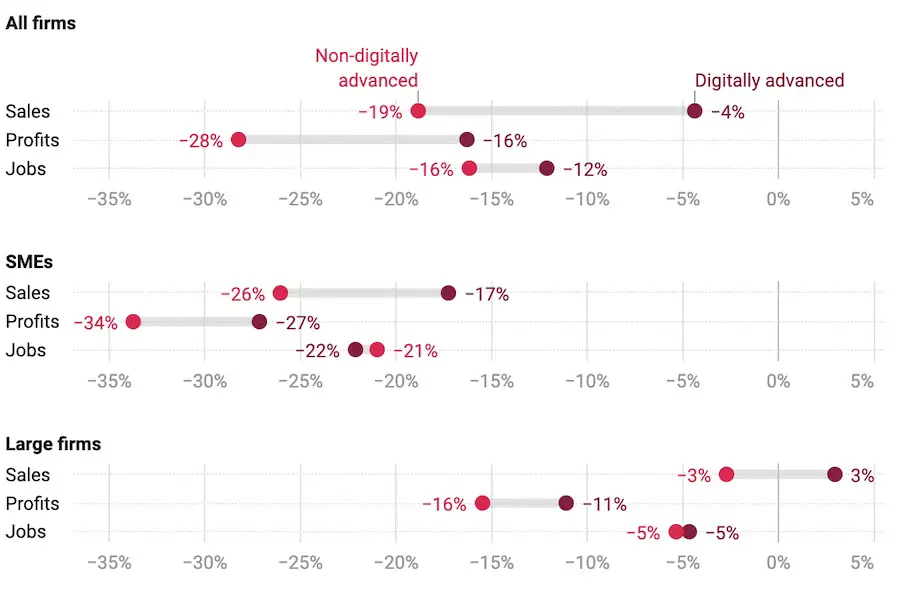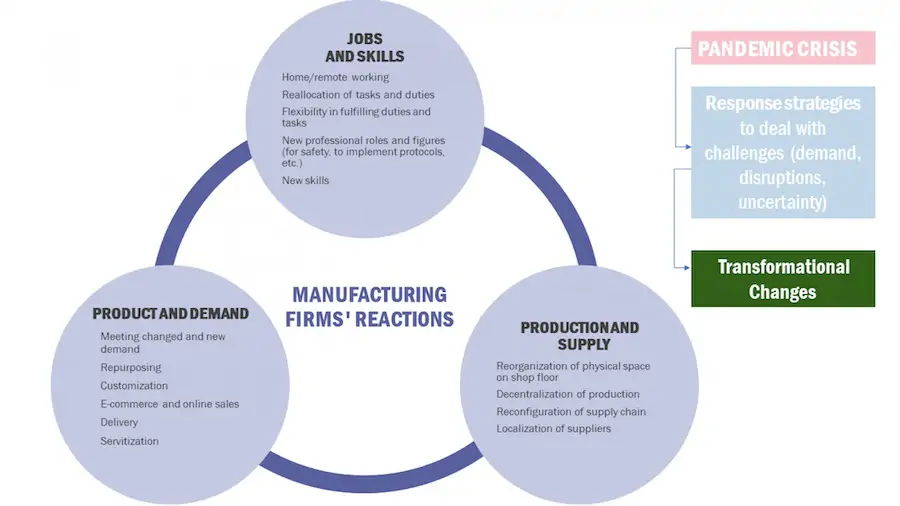
Building in Paris, France. (Image: Pierre Châtel-Innocenti via Unsplash)
Advanced digitalization is becoming one of the key drivers of industrial resilience and competitiveness.
The economic impact of COVID-19 on manufacturing industries around the world is now well-documented. Global manufacturing output fell by 11.4 per cent during the second quarter of 2020, compared to the same quarter of 2019, and only returned to growth by the end of the fourth quarter of 20201
Data collected on approximately 4,000 firms in 26 developing countries show that, on average, annual profits declined by 27 per cent between 2019 and 2020; that monthly sales fell by 17 per cent between 2020 and 2021, and that around 16 per cent of jobs have been laid-off since the start of the pandemic (see figure below). These averages, however, mask strong heterogeneities across firm sizes, with small and medium-sized enterprises (SMEs) suffering more than larger firms, though significant diversity is also observable within each group and across regions.
The impact of COVID-19 on manufacturing firms’ profits, sales and jobs
 Note: SMEs have up to 99 employees. Large firms have 100 or more employees. Profits = change in yearly profits in 2020 compared to 2019; Sales = change in monthly sales the month before the survey with respect to the same month one year before; Jobs = total laid-off workers at the time of the survey over the total number of workers in December 2019.Source: Authors elaboration based on UNIDO COVID-19 firm-level survey
Note: SMEs have up to 99 employees. Large firms have 100 or more employees. Profits = change in yearly profits in 2020 compared to 2019; Sales = change in monthly sales the month before the survey with respect to the same month one year before; Jobs = total laid-off workers at the time of the survey over the total number of workers in December 2019.Source: Authors elaboration based on UNIDO COVID-19 firm-level survey
Explaining this heterogeneity is important as it can point to resilience factors and inform preparedness strategies for future shocks. An analysis of the survey results suggests that country- and industry-specific factors—including the stringency of governments’ containment measures, the fiscal space to implement support policies and the labour intensity of industry—played a role in firms’ robustness. At the firm level, characteristics such as size, liquidity, skills, export orientation and digitalization were all important factors.2
It is important to explain this heterogeneity as it can point to resilience factors and inform preparedness strategies for future shocks.
Crucially, those few firms that do use ADP technologies tended to be less impacted by COVID-19 than others in the same size class.
Of these, digitalization–specifically, the use of advanced digital production (ADP) technologies–is of particular relevance as it has the capacity to support resilience along two dimensions: (i) by helping firms absorb shocks (robustness) and (ii) by helping firms react and respond to shocks (readiness). ADP technologies associated with the Fourth Industrial Revolution (4IR) are not yet widespread in most developing countries (see figure below), with less than 16 per cent average penetration in each of the three regions surveyed. Rather, most firms use either analogue or outdated digital technologies.
The use of digital technology by manufacturing firms around the world
 Note: Analogue/simple mechanization (or rigid production) refers to manual production and/or basic electronic stand-alone machinery with no or only specific use of basic digital technologies (e.g. Internet for emails). Automation (or lean production) refers to automated production with the use of some isolated digital technologies (e.g. design software for product development and manufacturing). Digitally advanced (or smart production) technologies entail the use of interconnected and Internet-based digital production technologies associated with the 4IR.Source: Authors elaboration based on UNIDO COVID-19 firm-level survey
Note: Analogue/simple mechanization (or rigid production) refers to manual production and/or basic electronic stand-alone machinery with no or only specific use of basic digital technologies (e.g. Internet for emails). Automation (or lean production) refers to automated production with the use of some isolated digital technologies (e.g. design software for product development and manufacturing). Digitally advanced (or smart production) technologies entail the use of interconnected and Internet-based digital production technologies associated with the 4IR.Source: Authors elaboration based on UNIDO COVID-19 firm-level survey
Crucially, the few firms that do use ADP technologies tended to be less impacted by COVID-19 than others in the same size class (see figure below). In other words, digitalization seems to have supported firms’ robustness to the shock.
Digitally advanced firms were more robust in absorbing the COVID-19 shock

Firms are dynamic entities that respond to changing circumstances by adjusting their strategies and reoptimizing new incentives and limitations. Following the outbreak of COVID-19, some manufacturing firms identified and adjusted one or more aspects of their activities, as illustrated in the figure below, to cope with the changed scenario and adapt to the “new normal” following the pandemic.
Responding to the crisis: Transformational changes as a response strategy
 Source: Calza et al (2021).
Source: Calza et al (2021).
Here again, digitalization supports transformation by, for example, facilitating the shift to remote work, where possible, and otherwise allowing for more flexible reorganization of production processes to accommodate safety measures and social distancing (see figure below).
Effect of digitalization on the implementation of response strategies
 Calza et al (2021).
Calza et al (2021).
This hypothesis is supported by the survey data, which indicate that digitally advanced firms consistently introduced more changes across all business strategies than their peers (see figure below).
Changes introduced by manufacturing firms to face the crisis
 Created with DatawrapperNote: The x-axis shows the share of firms. Digitally advanced firms = firms adopting ADP technologies.Source: Authors elaboration based on UNIDO COVID-19 firm-level survey
Created with DatawrapperNote: The x-axis shows the share of firms. Digitally advanced firms = firms adopting ADP technologies.Source: Authors elaboration based on UNIDO COVID-19 firm-level survey
The pivotal role of digitalization is confirmed by an econometric analysis, which controls for other factors such as firm size, ownership, innovation and production capabilities, participation in global supply chains and export orientation3. Not only did digitally advanced firms suffer less, on average, during the crisis; they were also more likely to react to the crisis by introducing transformational changes in their operations. Advanced digitalization has therefore become one of the key drivers of industrial resilience as well as competitiveness.
Advanced digitalization is therefore becoming one of the key drivers of industrial resilience, as well as competitiveness.
The diffusion of ADP technologies in manufacturing firms in developing countries, however, is still limited to a few cutting-edge firms that are typically large and well-integrated in global production networks. The vast majority of firms instead operate very far from the technological frontier, using outdated digital technologies or no digital technologies at all. This digital gap needs to be filled if industrializing countries are to succeed in the contemporary economic landscape and weather the inevitable shocks of the future.


